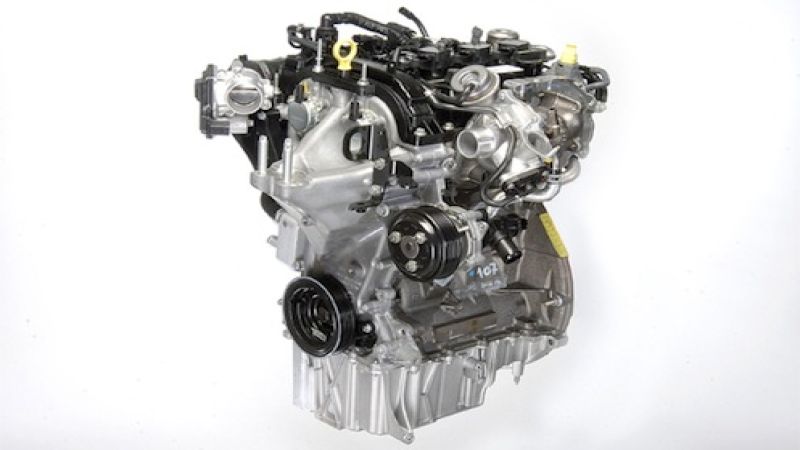Ford has announced that their new 1.0-liter EcoBoost engine has received the 2012 “International Engine of the Year” award along with winning the “Best New Engine” and “Best Engine Under 1.0-Liter” in the awards presented by Engine Technology International magazine. The new engine from Ford combines the latest technology and delivers some incredible fuel-mileage numbers. All the attention and awards are certainly well deserved.
The new 1.0-liter EcoBoost engine from Ford combines the latest technology to achieve an incredible 58.9 mpg. The engine uses a turbocharger, direct injection and variable valve timing to deliver both power and fuel efficiency. There are two versions of the little 1.0-liter engine. The new Focus engine produces 98 horsepower (58.9 mpg) and the larger 125 horsepower engine delivers 56.5 mpg. (Note these mpg estimates are based on European standards and could be slightly less in the U.S.)
The new three-cylinder engine from Ford is being used first in the European Ford Focus and will be offered in the C-MAX and B-MAX in Europe later this year. Ford will be offering the 1.0-liter fuel-efficient engine in Ford models in the U.S. sometime next year. The engine has been wildly accepted in Europe and should be a big hit when it is offered here in North America.
While we see much of the attention on electric and hybrid vehicles, the gasoline engine is alive and well and isn’t going away. “For a three-cylinder to power a vehicle like the Ford Focus with such ease proves the future is very, very bright for the internal combustion engine,” said Slavnich of Engine Technology International. And it’s not over yet, we’ll see even more advances made to the internal combustion engine in the future.
Other 1.0-liter EcoBoost innovations
Amazingly, Ford was able to produce the same amount of power and performance from the new 1.0-liter EcoBoost as they had with the naturally aspirated 1.6-liter engine it is replacing. They were able to accomplish this first by using an exhaust manifold, cast into the cylinder head, which lowers the temperature of exhaust gases to enable the optimum fuel-to-air ratio across a wider rev band.
A unique cast iron block warms the engine more quickly than a conventional aluminum block to cut the amount of “warm-up” energy required by 50 percent, and cut fuel consumption. And two main engine drive belts are immersed in oil to deliver a quieter, more efficient engine. Another energy-saving technology uses an offset engine configuration that unbalances the flywheel and pulley instead of adding energy-draining balancer shafts.
How does it compare to other engines
To give you an idea of what Ford has accomplished with this new EcoBoost 1.0-liter engine, lets compare it to another small engine built by Toyota. The 2012 Scion iQ is powered by a 1.3-liter four-cylinder engine that has even less horsepower at 94. But the naturally aspirated Scion iQ engine gets an EPA estimated 37 mpg highway fuel mileage compared to the Ford EcoBoost at 58.9. Those are the kind of numbers that could be a real global game-changer for Ford. It's no wonder the engine has been so successful in Europe.
The award-winning engine was designed at Ford’s technical centers in Dunton, U.K., and Merkenich, Germany. The engine is built in Ford’s plants in Craiova, Romania, and Cologne, Germany. With the fuel-stingy engine being successfully used in Europe, look for the new 1.0-liter EcoBoost engine in Ford products here in the U.S. sometime next year. This new engine design could have a major impact on engines in the future as Ford applies this technology on their four and six-cylinder powerplants.












Comments
People wake up! Ford wants
Permalink
People wake up! Ford wants you to think that this engine will get close to that 58.9 MPG in the USA. No way will it even get close to that MPG. Also, they compare a Toyota that get's 37 MPG using the American gallons to the Imperial gallons of Europe.
All true, but the article did
Permalink
In reply to People wake up! Ford wants by Anonymous (not verified)
All true, but the article did at least point out differences in European and American fuel efficiency measurements. I think the key issue is not small variations in how mileage is computed but the more important story of real and significant gains in fuel consumption efficiency. That gross difference will persist when the engine arrives in American built cars.
They flat out said it
Permalink
In reply to People wake up! Ford wants by Anonymous (not verified)
They flat out said it wouldn't get thatin he US. So....
Even considering the possible
Permalink
In reply to People wake up! Ford wants by Anonymous (not verified)
Even considering the possible difference in gallons (this is not clear in the article) the 1.0L would still show 47 mpg (US) if the correction is needed.
In the next handful of years,
Permalink
In the next handful of years, 3-cylinder engines will be taking over the small car segments and pushing average highway mileage over 50, just as high-output and efficiency 4cyl engines are making 40mpg the standard today.
the real game changer is
Permalink
the real game changer is 662hp and no gas guzzler tax. WOW
Being that this article
Permalink
Being that this article quotes mpg figures for a European Focus, it leaves us all wondering if those are US gallons or Imperial gallons. An imperial gallon has 20% more volume than a US gallon, so the difference is huge. To be crystal clear for both American and European readers, the article must reference either US gallons or Imperial gallons, otherwise mpg figures don't mean much.
0.8 times 58 = 46 ish,
Permalink
In reply to Being that this article by Anonymous (not verified)
0.8 times 58 = 46 ish, European vs US EPA cycles another 5-10% reduction. In other words it seems to get similar mileage as current US Focus, is that true?
Not to take anything away
Permalink
Not to take anything away from Ford, but back in 94 there was a 3 cylinder 1l Chevrolet Geo rated at more than 50mpg highway. That was pre-08 EPA numbers, so 15% exaggerated. In 95 the mileage dropped to 49mpg highway. That car was horrible to drive, very underpowered and in my experience, and never delivered even close to the EPA numbers. I got almost the same mileage in a Mitsubishi Mirage, and a Ford Escort, but they were much more fun to drive, far more roomy and more versatile. Oh, and they lasted much longer too.
Fords engine looks very promising. In a Fiesta, it should be much better than the base engine with 5 more HP and a much broader power band. If they can get mileage into the mid 40s or higher, it will leave have no real competition, except more expensive hybrids.
The Geo was made by Suzuki
Permalink
In reply to Not to take anything away by Anonymous (not verified)
The Geo was made by Suzuki and branded as a Chevy. Total pile of crap. It was a step sideways from the Yugo.
Look there is a reason it won
Permalink
Look there is a reason it won all the awards , it has less parts weighs less is much more efficient, is said to be the smoothest running ford engine , has 20 percent more power 20 percent less emmissions and has been out over a year in europe. and yes their fuel is much better than ours they have over 100 octane and thats why they get better milage and more power than our crappy usa fuel. so usually usa cars will get worse milage and have less power but its only about 10-15 % Gee cant you people be happy a USA company who didnt steal taxpayers money is kicking some serious donkey rear. ? T3I could list all the improvements on this engine and there are many but I doubt most of you would understand them, if you are interested in the TRUTH , just google it there are several vids on why this is revolutionary!
I concur, Paul F. The power
Permalink
In reply to Look there is a reason it won by Paul F (not verified)
I concur, Paul F. The power to weight and power to volume ratios are superb for this power class. The engine will also go down in history as pioneering the use of an oil-exposed cog belt to drive the camshafts. The previous example, of much less demanding application, came in the little Honda one-cylinder lawnmower engine. The acoustic and cost benefits of the flexible belt drive are such that its use will expand. Also noteworthy is the non-use of a costly balance shaft.